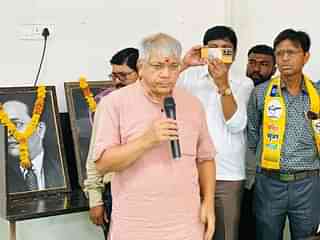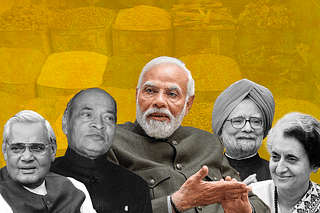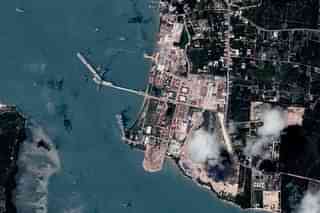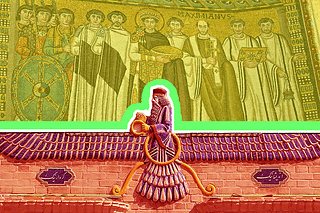Culture
Lachit Borphukan: Remembering The Ahom Hero On His Birth Anniversary
Ratnakar Sadasyula
Nov 24, 2021, 12:55 PM | Updated 12:55 PM IST
Save & read from anywhere!
Bookmark stories for easy access on any device or the Swarajya app.
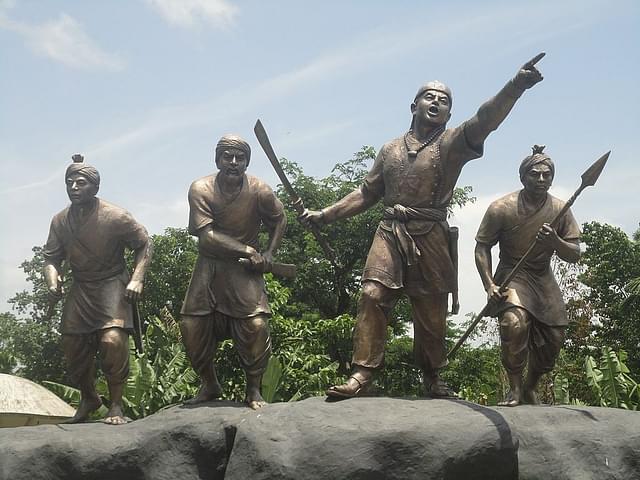
The Mughal empire expanded to its zenith under Aurangzeb, who pushed its boundaries to the farthest extent. And yet, paradoxically, the seeds of the empire’s destruction were also sown during his reign. One of the reasons was his religious bigotry, and his intolerance towards Hindus that alienated large sections of the population. His imposition of Jizya, destruction of temples, open hatred towards Hindus, and above all, the way he brutally tortured and killed his brother Dara Shikoh, who favoured a tolerant approach to all religions, alienated many. And the revolts broke out one by one. The Sikhs were the first, after Guru Teg Bahadur was beheaded, when he refused to hand over the Kashmir Pandits. The Marathas under Shivaji, harassed the mighty Mughal army with guerilla raids, taking back vast tracts of territory; and to the east was the Ahom kingdom of Assam.
While a lot is known about the Marathas, and the valour of Shivaji, not much is known about the Ahoms and their spirited resistance to the Mughals. When the Mughal Army attacked the Ahom Kingdom in the Battle of Itakhuli in 1682, it saw a decisive Ahom victory. This resulted in a Mughal retreat. The animosity between the Ahoms and the Mughal empire went long back. One of the primary factors being their alliance with their rival Koch Behar kingdom, and the other was the aggressive Mughal imperialism that sought to expand its territory into the North East, starting with Assam. The Mughals considered the territory east of Barnadi up to Singri as part of their empire, along with the rich natural resources of Assam. The very first foray the Mughals made into Assam, at Kajali in 1615, ended in a disaster, when the Ahoms regrouped after an initial loss, and reoccupied it, sending the Mughals back. While there was a brief lull in hostilities, the conflict again raised its head under Shahjahan’s reign.
One was the asylum given by the Ahom king to the hill chiefs of Dhanikal, fleeing from the tyrannical Bengal subedar Qasim Khan Chisti. Towards December 1636, Kamrup was occupied by the Mughals, though a gallant resistance was put up by the residents of Samdhara fort. The Treaty of Asurar Ali signed in 1639, between the Ahom general Momai Tamuli Borbarua and Allah Yar Khan, saw the entire Western part of Assam, till Guwahati pass under Mughal control. When Shahjahan fell ill, and his sons were caught in a bloody war of succession, Ahom king Jayadhwaj Singha took advantage of it, and chased out the Mughals from Assam and reoccupied the entire western region till Guwahati.
Lachit Borphukhan
One of the greatest warriors Assam had seen, their own Shivaji and Rana Pratap, was born to Momai Tamuli Borbarua, the commander-in-chief of the Ahom army. Borbarua was an office created by Pratap Singha, the Ahom king, also known as Sushengpaa, whose reign saw the expansion of the Ahom kingdom and was also regarded as a great administrator. In a sense, Pratap Singha, laid down the basic administrative structure of the Ahom rulers, which was followed after him. He was also successful in forging an alliance with Koch Hajo, the kingdom of the Koch rulers, which lay between the Sankosh and Bareli rivers. It was Pratap Singha, who created the offices of Borphukan and Borbarua, in addition to the existing offices of Burhagohain, Borgohain and Borpatrogohain. They were collectively called the 5 Patra Mantris. While Borphukan and Borbarua, respectively governed the areas, west and east of the Kaliabor River, Borgohain administered the region south of the Dikhow river, while Burhagohain, the northern side of the river. The Borpatragohain administered the region from Dafala Hills to the Brahmaputra.
Momai Tamuli started from very humble origins as a bondsman, and he was noticed by Pratap Singha, who pleased with his hard work, appointed him as the Bar Tamuli or the superintendent of Royal Gardens. His real name was Sukuti; he got his name from his position Tamuli and the fact that he was affectionately called as Momai (maternal uncle in Assamese). He rose to prominence during the Mughal wars due to his bravery and foresight, and played a crucial rule in the Treaty of Asurar Ali, so much that a Mughal envoy remarked, “If the Ahom ruler is a veritable Mahadeva, Momai Tamuli is his Nandi, and with them together, it is impossible to conquer that land”. Tamuli also played a major role in the administration and governance of the Ahom kingdom.
It was to such an illustrious man that a great son was born, Lachit Borphukan, who would rise to become one of the greatest heroes of Assam, and one of the symbols of resistance to the Mughal rule. When one writes about the history of resistance to the Mughals, Lachit Borphukan’s name would be there right up with Shivaji and Rana Pratap. Educated in humanities, military skills, and scriptures, he was first given the position of Soladhara Barua, the scarf-bearer of the Ahom swargdeo. In due course, he also held various positions like Ghora Barua (in charge of royal stable), commander of Simulgarh Fort and Dolakaxaria Barua (superintendent of royal household guards) to Chakradwaj Singha. He first came into prominence, when he recovered Guwahati from the Mughals in 1667, and was presented with the Hengdang, a gold-plated sword.
Battle of Saraighat
Lachit Borphukan would, however, come to be known due to his valour in the Battle of Saraighat, one of the worst defeats the Mughal Army would ever face. Saraighat would be remembered for the victory of a much smaller Ahom army over the mighty Mughal Army, through a combination of tactical brilliance, guerilla warfare and intelligence gathering. In a sense, Saraighat would be the last attempt by the Mughals to extend their empire into Assam.
The background to Saraighat was the humiliating Treaty of Ghilajarighat in 1663, which while returning Garhgaon back to the Ahoms, came at a heavy cost. According to the treaty, Jayadwaj Singha had to send one of his daughters to the imperial Mughal harem, supply 90 elephants, 300,000 tolas of silver and cede the entire region to the west of Bareli river on the north bank of Brahmaputra and Kalang on the South to Delhi. Jayadwaj Singha died heart broken due to the humiliation caused by the defeat at the hands of the Bengal Subedar Mir Jumla. His successor, Chakradwaj Singha, vowed to regain the honour of the Ahoms and began a complete overhaul of the kingdom. It was during this time that Lachit was made the commander of the army, which was undergoing a total restructuring. The alliances were renewed with the Jaintia and Kachari kingdoms, and in August 1667, Lachit accompanied by Atan Burhagohain, undertook a downstream expedition on Brahmaputra, to retake Guwahati.
Making Kaliabor his base camp, Lachit ensured Bahbari was retaken in September 1667 while the entire region between Guwahati and Kapili river too was reconquered. Guwahati was attacked from the river banks and the Shah Buruz, Rangamahal forts were also occupied. On 4 November, 1667, Itakhuli was taken in a daring midnight assault by the Ahoms, and many of its defenders were massacred. The Ahoms went in hot pursuit of the Mughal forces. Firuz Khan, the faujdar of Guwahati, was taken prisoner, and with the help of river warfare, removed the Mughals from Umananda and Barhat.
Alarmed at the losses, Aurangzeb sent a huge army under the command of Raja Ram Singh, son of the Amber Raja, Mirza Raja Jai Singh to retake Guwahati. By February 1669, Ram Singh reached Rangamati, accompanied by Rashid Khan and the Sikhs under Guru Tegh Bahadur. It was a massive army of 4,000 troopers, 30,000 infantry men, 21 Rajput chiefs with their contingents, 18,000 cavalries, 2,000 archers and 40 ships. On getting wind of the information, Lachit broke down, wondering how the Ahom kingdom could withstand the assault of such a mighty army. Also, the forces of Koch Bihar joined the ranks, making the Ahoms virtually outnumbered.
It was in such a dire situation that Lachit showed his tactical brilliance. Knowing very well that the Ahoms had no chance in an open field battle, he chose Guwahati with its hilly terrain. The only way up to Guwahati from the east was the Brahmaputra river. It was at Saraighat, where the Brahmaputra was at its narrowest point - just a width of 1 km - ideal for naval defence. While the Mughal army was the strongest on land, especially in open plains, their weakest point was their navy. Lachit set up a series of mud embankments in Guwahati and ensured that the Mughals would be forced to take the river route to the city. Andharubali,between Kamakhya and Sukreshwar hills, was where Lachit would set up his headquarters and monitor the war operations.
Lachit then planned a strategic retreat to Guwahati, ensuring that the Mughal forces were in sight, but their weapons could not reach. The Mughals had four divisions - one headed by Ram Singh (northern bank), Ali Akbar Khan headed the southern bank, the entrance to the Sindhurighopa was headed by Jahir Beg and the Baruas from Koch Bihar, while the naval commanders led by Mansur Khan, guarded the river.
The Ahoms, on the other hand, were allied with the Jaintias, Garos, Nagas, the Rani of Darrang and above all the monsoon. Atan Burhagohain commanded the northern bank while Lachit himself commanded the southern bank. Atan harassed the Mughal army with dagga judha (guerilla warfare) periodically, in the lead up to the battle. In the meantime, there was a fiercely fought skirmish at Alaboi, where the Ahoms faced a major reversal with around 10,000 Ahom soldiers massacred. A last-ditch attempt to persuade the Ahom ruler Chakradwaj Singha to surrender peacefully failed when Atan Burhagohain rejected it, saying there was no guarantee that Aurangzeb would abide by Ram Singh’s proposal.
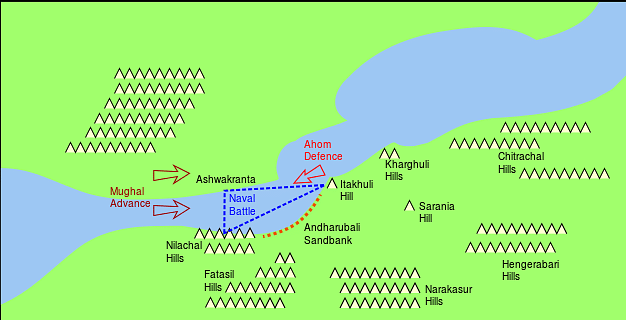
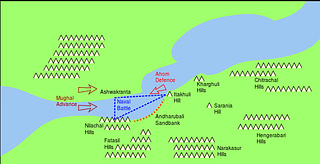
With peace talks failing, Ram Singh now made the final assault on Guwahati, with the reinforcements arriving in the shape of war vessels and imperial officers. Moving along the northern bank, he was joined by ships with artillery and archers under five Rajput Sardars. The Ahoms already demoralised by their loss at Alboi had to face another blow, when Lachit himself became seriously ill. The battle started on both land and water at Ashwarkanta, Laluk Phukan, pushed back the Mughals, but their naval forces compelled the Ahom boats to retreat further. With the Mughals getting dangerously close to Andharubali, the Ahoms retreated further back to Kajali and Samdhara. And this is when Lachit Borphukan stood up to be counted, disregarding his illness. He sent orders for all the land and naval forces to attack, ordered seven war boats for himself. “The king has put all the people in my hands to fight the Bongal” he thundered, as he headed towards the battle.
Lachit’s entry had an electrifying impact on the Ahom soldiers, who now attacked the Mughals fiercely. Ahom warships now began to attack the Mughal navy from all sides. Between Itajuli, Kamakhya and Aswakranta, one of the fiercest river battles was ever fought. Using an improvised bridge of boats, the Ahoms attacked the Mughals from both the rear and front, their admiral Munnawar Khan was shot dead, and it totally scattered them. More than 4,000 soldiers of the Mughal army were dead, their navy destroyed, and they were pushed to the westernmost part of the Ahom kingdom, the Manas river. Darrang also saw a rout for the Mughals, overall it was a total rout for the Mughals, and ensured that they would not make further inroads into Assam. Lachit Borphukan single-handedly led the Ahom force to victory over a much larger Mughal army. It was one of the greatest military victories ever.
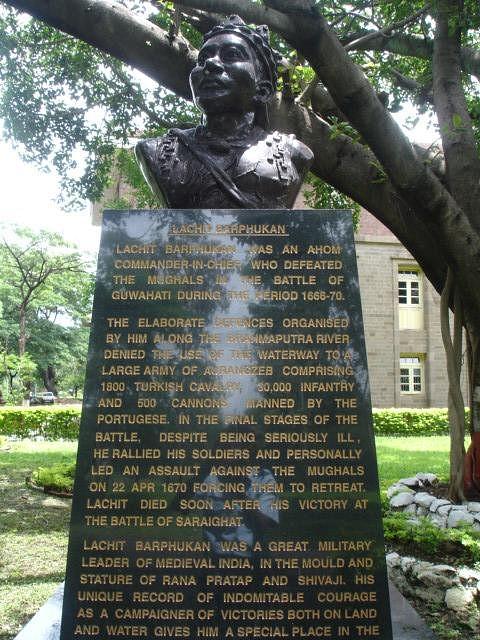
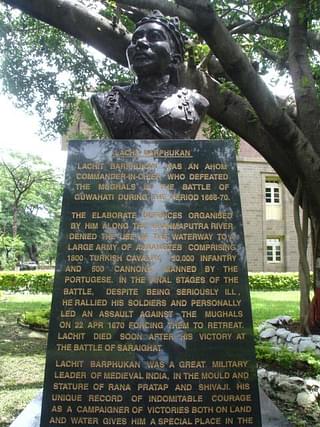
The best passing out cadet at the National Defence Academy is awarded the Lachit Borphukan gold medal, which was instituted by the Assam Government in 2000. It is a fitting tribute to a brave soldier, a wise man and a brilliant tactician.
This piece was first published on the blog ‘History Under Your Feet’ and has been republished here with permission.
Save & read from anywhere!
Bookmark stories for easy access on any device or the Swarajya app.
Ratnakar Sadasyula is an IT professional who writes code for a living, and writes when free to keep his sanity intact. Also a blogger, and now starting out as a self published author of sorts, with varied interests in history, science, Indian culture. Believes that knowledge is meant to be shared, and a learner for life.
Introducing ElectionsHQ + 50 Ground Reports Project
The 2024 elections might seem easy to guess, but there are some important questions that shouldn't be missed.
Do freebies still sway voters? Do people prioritise infrastructure when voting? How will Punjab vote?
The answers to these questions provide great insights into where we, as a country, are headed in the years to come.
Swarajya is starting a project with an aim to do 50 solid ground stories and a smart commentary service on WhatsApp, a one-of-a-kind. We'd love your support during this election season.
Click below to contribute.

